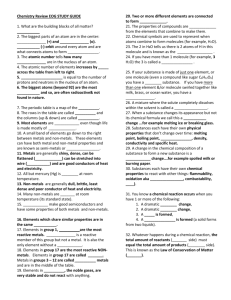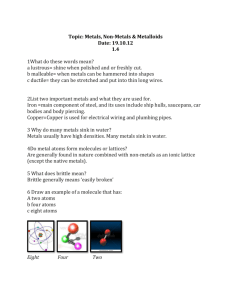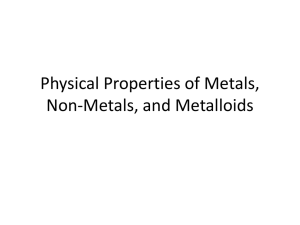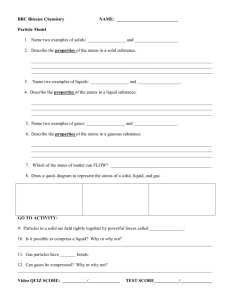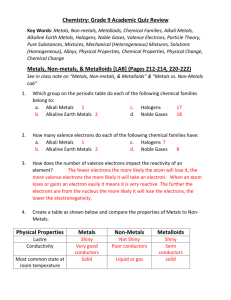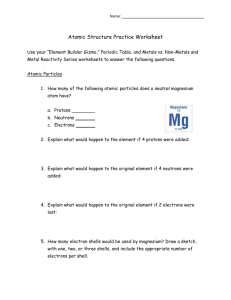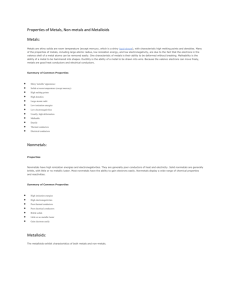Unit 4 Review Sheet
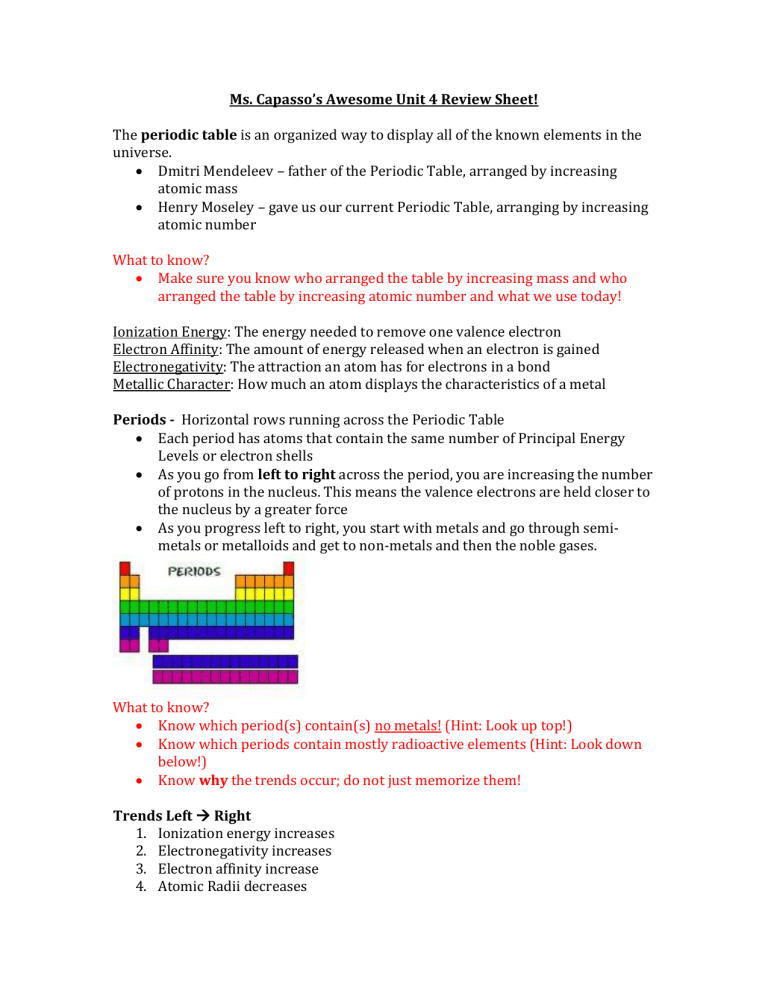
Ms. Capasso’s Awesome Unit 4 Review Sheet!
The periodic table is an organized way to display all of the known elements in the universe.
Dmitri Mendeleev – father of the Periodic Table, arranged by increasing atomic mass
Henry Moseley – gave us our current Periodic Table, arranging by increasing atomic number
What to know?
Make sure you know who arranged the table by increasing mass and who arranged the table by increasing atomic number and what we use today!
Ionization Energy: The energy needed to remove one valence electron
Electron Affinity: The amount of energy released when an electron is gained
Electronegativity: The attraction an atom has for electrons in a bond
Metallic Character: How much an atom displays the characteristics of a metal
Periods - Horizontal rows running across the Periodic Table
Each period has atoms that contain the same number of Principal Energy
Levels or electron shells
As you go from left to right across the period, you are increasing the number of protons in the nucleus. This means the valence electrons are held closer to the nucleus by a greater force
As you progress left to right, you start with metals and go through semimetals or metalloids and get to non-metals and then the noble gases.
What to know?
Know which period(s) contain(s) no metals! (Hint: Look up top!)
Know which periods contain mostly radioactive elements (Hint: Look down below!)
Know why the trends occur; do not just memorize them!
Trends Left Right
1.
Ionization energy increases
2.
Electronegativity increases
3.
Electron affinity increase
4.
Atomic Radii decreases
5.
Metallic character decreases
Groups - The vertical groups are called families.
The most important thing to know about the families are that they all have the same number of valence electrons
As you go down a family, you are increasing the number of complete electrons shells underneath the valence shell. These shells act as a shield and shield the valence electrons from the positive charge of the nucleus
Trends Top Bottom
1.
Ionization energy decreases
2.
Electronegativity decreases
3.
Electron affinity decrease
4.
Atomic Radii increases
5.
Metallic character increases
Ionic Radii
Cations lose electrons, get smaller
Anions gain electrons, get larger
What you need to know?
Which elements tend to gain or lose electrons
How the size of their ionic radii will compare to the neutral atom
Properties of Metals, Metalloids and Non-Metals
Metals
High melting points
High boiling points
Malleable – able to be hammered into various shapes
Ductile – able to be stretched into wire
Good conductors of electricity in all states! (Note: ionic compounds are electrolytes and are only capable of conducting electricity in the liquid state or dissolved in water! They are also brittle which helps differentiate)
Solid at room temperature
Have luster – shine
Low ionization energies and low electronegativities
Lose electrons, form smaller positive ions
Non-Metals
Can be gases, molecular solids or network solids at room temperature
Bromine is liquid at room temp.
Not ductile
If solid at room temperature, tends to be brittle (exception: network solids are very hard)
High ionization energy and electronegativity
Poor conductors of heat and electricity
Tend to gain electrons forming anions that are larger than their neutral atoms.
Allotropes
Some nonmetals can exist in two or more forms in the same phase – these are called allotropes
Examples: O
2
and O
3
– “air” and ozone
Diamond, coal and graphite – three forms of carbon
STRUCTURE DETERMINES FUNCTION! If the allotropes all have different structures, they must have different functions and properties.
What to know?
Make sure you can identify the metals, non-metals and metalloids on the
Periodic Table
If given certain properties, make sure you can determine if that thing is a metal, non-metal or metalloid
Be able to predict ion formations for the various groups. If I told you there was a new element found called Capasso-ium (X) and it bonded with oxygen to form this compound X
2
O, what ground would it be in? Hint: What charge would the ion have? +1….
The Families – What To Know
Alkali
Extremely reactive!
Do not exist in their elemental form in nature.
Form +1 cations
React explosively with water
Most metallic character
Alkaline Earth Metals
Very reactive
Slightly less reactive than alkali metals
Form +2 cations
Not found in nature in elemental form
Metalloids
B, Si, Ge, As, Sb and Te
Display both metal and non-metal characteristics
Semi-conductors! “Silicon Valley”
Group 14
Carbon – important for living beings
Silicon – an important metalloid
Contains non-metals, metalloids and metals
Tetravalent – can for four bonds
Group 15
Contains non-metals, metalloids and metals
Non-metals (N and P) form -3 anions
N important for agriculture
Group 16
Contains non-metals, metalloids and metals
Oxygen is an important non-metal for living beings
Group 17
Contains non-metals, metalloids and metals
Exist in all three phases (F and Cl are gases, Br is a liquid and I is a solid)
Contains only non-metals
Held together by London Dispersion Forces
Form -1 Anions
Noble Gases
Stable Octet (Neon is stable with 2 electrons)
Non-reactive
All gases at room temperature
Held together by London Dispersion Forces
Transition Metals
Partially filled d-sublevel
Hard solids with high melting point (except for mercury)
Form ions that are colored!
Lanthanides/Actinides
F-block
Rare earth
What to know?
General properties of each family
State of elements at room temp. and the diatomic elements
Where each family is located
Balancing Chemical Equations
Reactants: What you start with, on the left
Product: What you end up with, on the left
The number of atoms for each element in the reactants must balance with the number of atoms in the products
The Law of Conservation of Mass states that the mass of the reactants must equal the mass of the products.
When balancing equations, you can only change the coefficients!
Top Five Chemical Equations
1.
Single Displacement a.
In an ionic compound, either a more reactive metal replaces the cation or a more reactive halogen replaces the anion b.
Example: NaCl + Li LiCl + Na c.
Example 2: NaBr + Cl
2
NaCl + Br
2
2.
Double Displacement a.
In an ionic compound, the cations of two compounds “switch partners” creating two new ionic compounds b.
Don’t forget how to recognize your polyatomic ions!!!!!!!!!
c.
Example: 2 HNO
3
(aq) + Na
2
SO
3
(aq) 2 NaNO
3
(aq) + H 2 7SO
3
(aq)
3.
Combustion: a.
Always a hydrocarbon (carbon bound to lots of hydrogen) plus O
2 producing CO
2
plus H
2
O
4.
Synthesis: a.
Small molecules or elements combining b.
Usually exothermic c.
2 Mg(s) + O
2
2 MgO (s)
5.
Combustion: a.
A large molecule being split up into smaller molecules b.
Endothermic c.
2 NaCl (s) 2 Na(s) + Cl
2
(g)
Balancing Equations!
1.
Draw a chart with three columns – elements, # atoms reactants, # atoms product
2.
Put the symbols for the elements present in column 1
3.
Put the # of ATOMS of each element in the reactant in column 1
4.
Put the # of ATOMS of each element in the product in column 2
5.
Notice which elements are unbalanced; change the coefficient of one of the compounds or atoms above to try to balance it
6.
Change the atoms in your columns below
7.
Notice if it is still unbalanced; repeat steps 5 and 6
Helpful Hints
Put a star next to any elements that occur in more than one compound so that you remember
Balance the elements that occur in only one compound in p and r first; then balance the elements that occur in multiple compounds
Balance metals first, then polyatomics, then non-metals
Balance elements not in a compound last; these will usually be easier to balance
If a polyatomic ion does not get broken down, try to balance it as a whole unit

